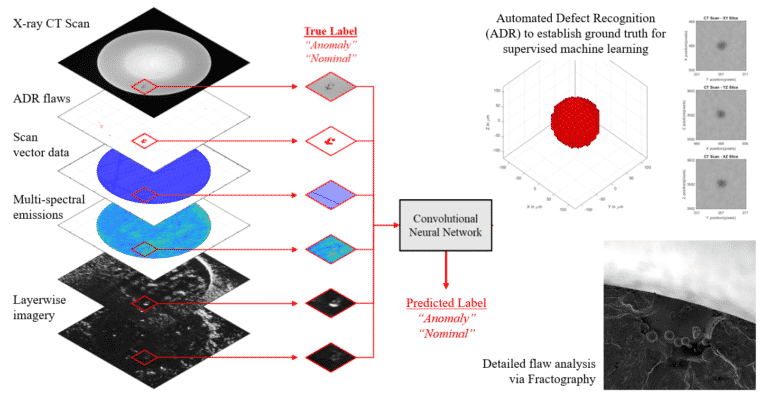Development of machine learning algorithms to identify flaws with in-situ sensors and correlation of these flaws to fatigue performance.

Problem
Additive manufacturing (AM) production methods require strict dynamic control of processing parameters and process conditions to achieve high-quality, fully dense components. Numerous flaws, however, may be inadvertently generated during the build when process parameters and conditions deviate or when unforeseen disturbances influence the process. Post process inspection technologies, such as high-resolution 3D X-ray computed tomography (XCT), are available to identify these flaws but there is a pressing need for reliable in-process sensing technologies and associated data analytics that can be employed to enable in-situ monitoring, quality assessment, and even corrective action.
Objective
The objective of this project was to establish a quantifiable correlation between the in-situ sensor footprint, process anomalies (i.e. build flaws), and part quality as derived from fatigue testing. The project sought to use machine learning techniques (a convolutional neural network) to correlate in-situ process monitoring data to flaws identified in post-build XCT scans, thereby discriminating flaws from nominal build conditions. An additional objective was to couple the presence of flaws (both those identified in-situ and by XCT) to actual fatigue performance.
Technical Approach
The Pennsylvania State University led the effort from their Applied Research Laboratory. Test coupons were previously printed by powder bed fusion (PBF) AM, and several sensor modalities (layer-wise imagery, multi-spectral emissions, and scan vector data) were captured during the build process. X-ray computed tomography and an automated defect recognition algorithm were used to identify build flaws in these test coupons. The coupons were then fatigue tested in the non-HIPd condition. Fractography was used to determine the cause of failure. The identified build flaws and fracture locations were then registered to the machine build plate coordinate system. Data from multiple in-situ sensor modalities was processed and also registered to the machine build plate coordinate system. A machine learning algorithm (a convolutional neural network) was trained on the sensor data and tested on data from an identical but independent build. The flaw data was then correlated to the results of the fatigue testing and fractography using machine learning and regression techniques.
Accomplishments
The project developed a scalable framework to extract in-situ sensor footprints for PBFAM processes. Sensor footprints are defined by data samples collected in a spatial, three-dimensional (3D) neighborhood around the location of interest, i.e. known flaw locations. The physical size of the neighborhood is a design parameter that balances complexity and information content against computational bandwidth requirements and potential data redundancies. While the sensor footprints in this study contained layerwise imagery, multi-spectral emissions, and scan vector information, they could be extended with additional sensor modalities (e.g. acoustics) if needed. Classification performance of >95 % was observed using test data gathered from a different build. In addition, information content for each modality and subsets of modalities was formally established in order to guide future sensor selection and integration efforts. Detected flaws, e.g. size, morphology, and densities were correlated to fatigue properties, and strong correlations were established between fractographic measurements and fatigue lifetimes. Moreover, the machine learning classifier was consistently able to detect stochastic, failure-initiating flaws, demonstrating the practical viability of the overall approach for real-time flaw detection and potential automated correction (remelting) in the future.
Project Participants
Project Principal

Public Participants
- U.S. Department of Defense


